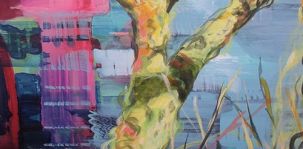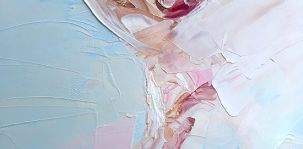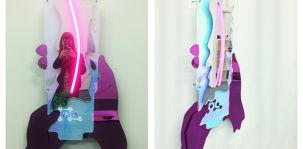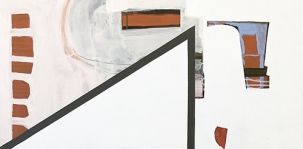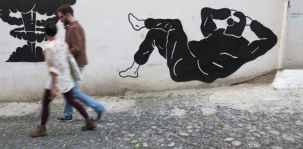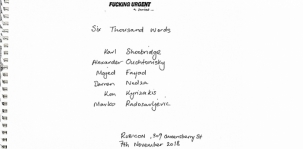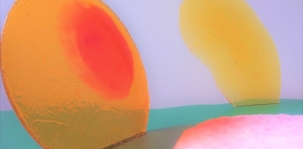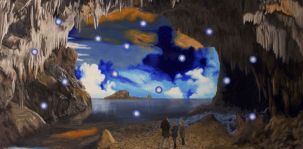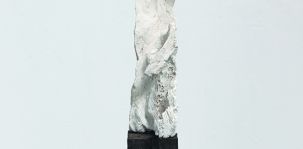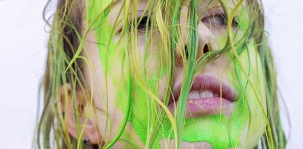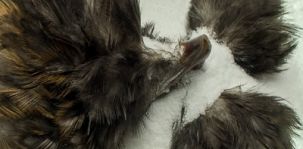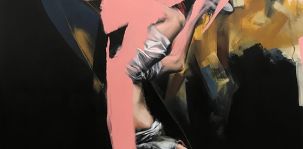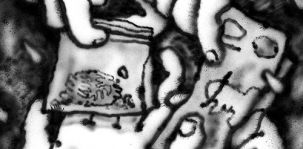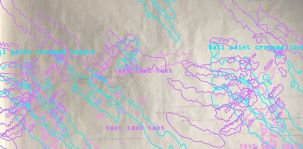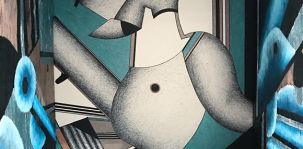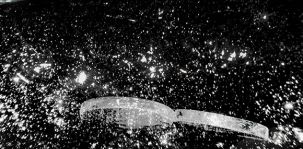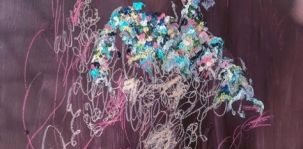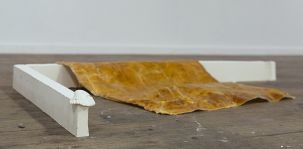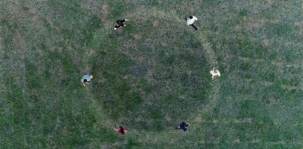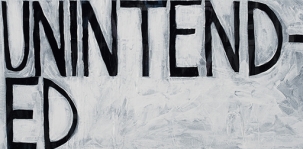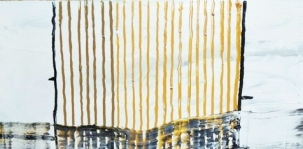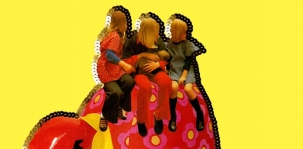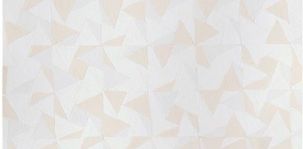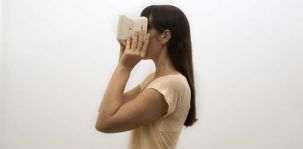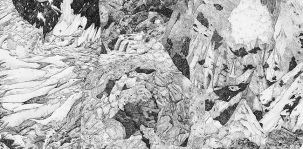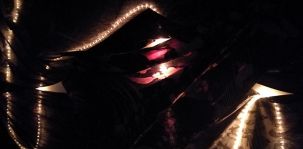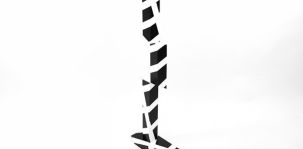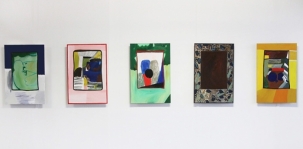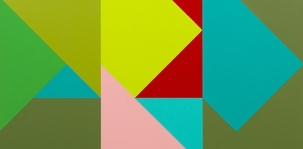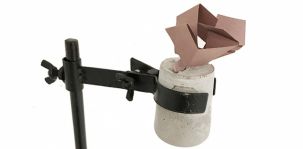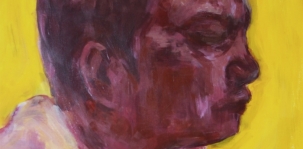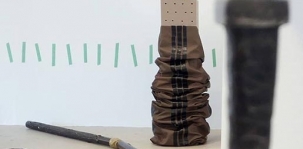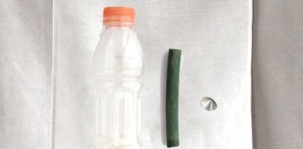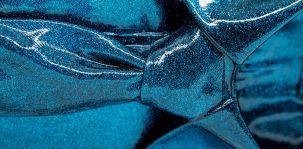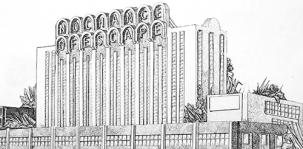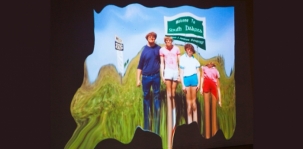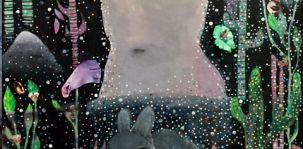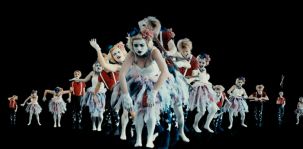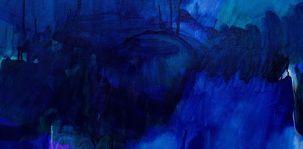Archive : 2018
November 28 - December 15, 2018
Ash Coates
Ash Coates work draws from images of both real and imaginary places, to examine relationships between micro and macro worlds and the language, forms and networks that exist within our biosphere.
The languages and symbiotic relationships of plants, fungi and bacteria cultures, give rise to transformations of microorganisms, energy fluctuations, transmigration of cells and the distribution of nutrients within the environment and our bodies. It is these processes that influence and form the shapes, composition and psychedelic tones within these works. The paintings are a process of ritual and meditation on things both massive and microscopic, magic and scientific, internal and external.
Using both painting and moving image the artist aims to examine and create dialog in regard to the boundaries of what is natural and what is artificial within the environment and the point where science meets science fiction.
Michael Armstrong
This series of paintings explores the narrative and durational aspects within the still image. The paint is applied in ribbons of oil paint that act as pathways. An unspoken invitation to follow the folds as though walking through a maze. Discovering the way in which the painting was constructed and how the representational aspects drift in and out. The materiality of the medium disrupts the development of the image. Achieving a state of flux and dissipation and opening the conversation between the object and its content. .
Kate Geck
The art works in RLX :tech centre on imagined artisan objects for the home that are imbued with therapeutic technology. These are wall hangings or small sculptures that can be scanned with a free app to reveal an augmented reality overlay of guided meditations and abstract imagery. A selection of small acrylic, neon and metal works on the walls will trigger abstract image and sound content when scanned with the audience's own smartphone (after downloading the free app). Kate Geck is interested in moving away from the guided meditations she has been working with to date in order to experiment with more abstract AR overlays - to create a greater sense of immersion in the space and oneness with the work.
November 7 - November 24, 2018
Anna Steele
There is a window of time that divides the moment between deconstruction and how a space is reconstructed and utilised differently. This interstitial space between absence and presence in the landscape becomes an evacuation of the known and a confrontation with the unknown. We wait, we catch glimpses, a change happens before us, without us. We then live with a new architectural presence, a form that has been decided for us. My process, when I aim represent this notion in a 2-dimensional manner (painting), is through a series of layered observations that reduce as well as evolve in to a balanced composition of density and space.
Karl Shoobridge, Alexander Ouchtomsky, Majed Fayad, Darren Nedza, Kon Kyrizakis, Marko Radosavljevic
October 17 - November 3, 2018
Callum Jackson
Callum Jackson’s solo exhibition, Calm Your Teenage River, examines the role of nostalgia in the modern era. Through print-based media, painting and drawing Jackson has produced a suite of work that investigates the significance of nostalgia, and if it is a force that can stimulate progression or lead to stagnation.
Louise Gresswell
Central to Gresswell’s practice is the materiality of paint and surface as she explores concepts of vulnerability and protection. Her paintings are created in response to various histories - both personal and art historical. ‘Sensory narratives’ are formed by transferring that which is felt from hand to board, generating textured and rich surfaces with evidence of the artists’ touch.
Christopher Jewitt
Christopher Jewitt is a self-taught artist. His work sits outside of the prescribed system, rules and formalities. Inspired by Donald Moffett, his work plays with materials as much as it plays with colours. Taking his hand beyond the paintbrush, Chris integrates everyday building materials on to the frame in order to add layers that build his canvas and create a new sculptural form. This body of work is inspired by the want to blend kitsch and otherworldly materials creating works that are starkly contrasted to what would exist in a traditional gallery space. Here Chris creates a playful synergy. These everyday found materials are integrated into his artwork to create a vortex of exchange, expressing a tactile quality which offers unexpected familiarity, while also seeming completely unearthly.
This current body of work is an expression of possibility, fantasy and imperfection. The materials exude a desire to touch, rather than be admired for their arrangement. What else could these materials do? How do they interact when we’re not watching?For Chris, the bubbled borders evoke ideas about air travel and space travel and fluffy, bouncy and dramatic landings; and in some instances indifferent performances of digestion, and daily hygiene routines. The arrangement of floral backgrounds suggests heavenly delights, or a vestige of perfection in a fairy-tale garden state. Here, Chris seeks to animate combinations of shape and style that subvert conventional order. The characters and narratives within the frame seem impulsive like theatre - at once pretty and ugly, dynamic and stagnant.
September 26 - October 13, 2018
Anna Schwann
The moving finger
When it strikes, it leaves an indelible mark, something clear and true, unmistakable.
This body of work explores the translation of musical stimuli into the physical realm. Like lucid dreaming allows conscious thought to guide the subconscious, listening to the shapes and textures emerging from the notes that become three dimensional form. Engaging in a deliberate state of chromesthesia giving insight into the colour of sound, how deep, how light, how lush.
Power lies within these chords, the muse and author Dorothy Ashby lived as a pioneer, forging her own path in a place dominated by tradition, poverty and race inequality to birth a sound most true to herself. This is a tribute to her work.
Christine Myerscough
In a practice that encompasses photography and sculpture often using found objects or imagery Christine Myerscough’s series ‘Too Late Too Cloudy’ layers a sequence of photographic images in an enigmatic play of appropriation and re-creation. Her images and characteristics are more akin to drawing or painting, of soft stains and visual noise, animated by the accumulative intervention of the artist’ direction and speculation. Myerscough collapses and condenses her series of images, creating works that propose new visual and conceptual terms to consider and distil historical photographic practices.
Richard Knafelc
Richard Knafelc’s representational paintings in his 'Visions Before Midnight' series explore strangeness, mystery, the unexplained, and dream-like states. He achieves this by utilising depictions of lights or stars which appear to float through highly coloured, unreal landscapes.
Knafelc is influenced by the philosopher Plato’s work 'The Republic'. An interpretation of Plato’s writings is that in the world, physical objects we perceive with our senses are but shadows of their ideal or perfect forms. Knafelc uses this as a departure point to examine our perception of the material world and its representation, and think about what might exist beyond the physical realm.
The titles of the works reference philosophical ideas, invented personal stories, and psychological phenomenology, and add a further layer of meaning and ambiguity.
Dr Richard Knafelc is a contemporary painter living and working in Melbourne. In 2017 he completed a Master of Fine Art with Distinction at RMIT University, mentored by Dr Jan Nelson. Knafelc has been selected as a finalist in several major prizes including: the Sulman Prize, the Archibald Prize Salon des Refusés, the Bayside Acquisitive Art Prize, and the Gold Coast Art Prize.
September 5 - September 22, 2018
Paul Kalemba
Sometimes Humorously, sometimes deadpan, Some Things Cannot Be Undone explores the notions of nature and ecology in the Anthropocene through found object assemblage and still-life photography. Removing the nature/culture binary, and with a hint of myth and the occult, Kalemba attempts a playful collaboration with phenomena and found objects. The objects, presented as subjects, with deliberate use of pareidolia (seeing patterns or faces in random data) attempt to arouse empathy within the viewer . . . Or at least a sense of humor. While inviting a questioning of the prevailing anthropocentric worldview, the works explore agency of the non-human and the abject positioning of nature to suggest contemporary stories of ecology and place.
Paul J. Kalemba is a Melbourne-based artist. He finished his Master degree of Visual Art at the the University of Melbourne and earned several finalists, such as the “Still; National Still-Life Award. Coffs Harbor Regional Gallery”, “Banyule Award for Works on Paper” and “The Nillumbik”. In 2018 and 2011, Paul had residency projects in Iceland for “Icelandic Notes for the Weltgeist: SIM Residency” and in Riverbend for “The Symbiogenisis project: Laughing Waters”. Paul’s artistic practice extends across drawing/work on paper, new media, photography and sculpture. His latest work explores the nature and ecology in the Anthropocene through found object and still life compositions. His artworks also became a part of collections in several institutions, such as the Hepburn Shire and the Nillumbik Shire.
Amanda Page
In capturing and recording changes of state in materials and processes, Amanda Page makes works about transformation. Phenomena and the coalescing and dissipation of natural systems are investigated. Change is explored as a universal condition that connects all matter. All things move toward their end records erosion and references fragility, loss and impermanence. The works developed from observing ice formations around Antarctica and Iceland.
Amanda Page makes works about transformation, in capturing and recording changes of state in materials and processes. While the works reference ecology and climate and can be positioned within the framework of environmental art, they also reference change as a universal condition that connects all matter. Works develop from observing transformative processes in natural systems and phenomena, such as weather patterns, temperature, erosion, interaction between organisms, metamorphosis, growth and decay, where organic substances break down into simpler forms of matter, and how matter and energy change under varying circumstance.
Page uses water, ice, sunlight, fire and camera-less exposure processes combined with drawing, printmaking and sculptural methods to catalyse, explore and articulate processes of change. By using constructed parameters, Page records the processes of melting, freezing, molding and transforming materials into various states. Perishable materials reference fragility, loss and impermanence in natural systems and capture the interaction of invisible forces and energies.
Clare Ellison Jakes
The multimedia installation, ‘as sane as a bloody meataxe’, is an investigation into the following text, written by the artist: ‘When Dorothy fell through the rainbow, she wasn’t expecting record highs all winter, all summer and year//; So perhaps now she just needs some rest; but instead I’m chugging down chartruese, whispering “I love you, I love me, love me” relentlessly//; So do you mind if we kiss rather than hugging goodbye? After all, I’m– we’re as sane as a bloody meataxe.’
Clare Ellison Jakes is a Melbourne-based artist and collaborator who graduated from the Victoria College of the Arts (VCA) with Bachelor of Fine Arts (Visual Art) in 2017. Her latest show is “When I think of beauty I think of decay” at the Alternating Current Art Space in Melbourne. She has had several commercial projects, such as “Interior designer/muralist and video producer for Edrolo”, Collaboration with A.K.A Coffee and Mecca Cosmetica Holiday Campaign. Her artworks also are a part of collections across Australia, New Zealand and Denmark.
August 15 - September 1, 2018
Karleng Lim
Move over climate change denialists, Holocaust deniers, flat-earthers and post-truthers. Audrey the Chicken-who-did-not-die-an-unremarkable-death has a new truth. She is now in the business of divination, post-death, as a two-bit fortune teller, quite literally.
Nadine Lineham
Uncontainable calm, questions what it is to live in a world of accelerating change, where the era of mass media circulation offers a prescription for life; news, fake news, desire, hope and deceit on relay. The project aims to manipulate familiar images that are believed to carry meaning and capture the paradox that can emerge. The parts of human nature that try to remain on authentic autopilot, but beneath the surface lurks a charming anxious social identity that violently erupts, stares and behaves inappropriately. Lineham’s abstract/figurative oil paintings explore the dichotomy between the lengths one may go to exert power or conform to a set of ideals, compared with those that disconnect from society, are powerless or feel alienated. The hope of obtaining a sense of calm that can be contained seems to be out of reach, constantly falling out of reach. Her approach is to make the work partially redemptive as well as to indicate a philosophical dimension: the interconnection between evidence and the space shifting form of one’s perception.
Jared Winchester
In the early months of 2015 I committed myself to filling one A4 sized every day, with the intention breaking my resistance to making work. I felt if I woke up and immediately scribbled something down I could not only foster a practice of self discipline towards making art, but I could also get my ‘failure’ out of the way. The fail- ure on arrival mindset gradually transitioned into a more serious, labor intensive approach. ‘Bottomless Pit’ is a presentation of works that resulted from a later part of this project (mid 2016 to late 2017) that I feel where the best examples of this practice. A bottomless pit refers to a place demons are imprisoned. As the project unfolded it took on a diary like quality and became somewhat of an exorcism, bringing light to these demons. Many are informed by following my curiosity on the internet, and my reflections on personal situations/relationships with others. The works confess to my existential anxieties, under-formulated philosophies and un- certainties. With this work I hope to present a uncontrived view the inner dialogues as indicators of personality and its transformations.
July 25 - August 11, 2018
Hannah Chamley
A plot is plan, in action and space. It is a devised sequence of points, their relation to one another seemingly determined in advance. The plot exists in time, in capacity, and only through output. The plot is used amongst an array of enterprise, in an effort to resolve measurement between marks, manage the succession of time and to express a decision or intention to affect. In industry it is used to demarcate ownership and devise location. In narrative it is used to intend direction and give line to a path. How do we use a plot to reconcile our experience within physicality? Is the devising of a plan the only part we can determine?
Plot uses a make-believe Marker of a series of hypothetical patterns to explore these concerns. A Marker is a plot used in the garment production industry to plan the shape of pattern-pieces and how these will relate in their intended cutting. The Marker is made on a plotter, a machine that feeds paper under a demarcating pen. The ball-point pen records the information leaving the system of the pattern making program. This hard copy of vector lines is a reflection of how intention can take form.
The Markers in Plotting, show mused shapes of clouds and hair, two objects associated with thinking. One may pull and twist their hair when they think or reflect. One may gaze at clouds and ponder or plan. These shapes or ‘patterns’ are given names. The Pattern pieces and the naming text of each piece is plotted on two separate markers. The shapes and text work together to show an abstracted plan, and a networked potential plotting. A scaping of their pieces’ lines and words explores the shape of a plot and its efforts to give assurance through determinism. Here the pre-meditated method of a garment is abstracted to interrogate the method of decision making in design, and in the greater context of any individual’s free choice.
Tania Matilda
Everything that can be seen can be broken down into shapes and colours. Tania Matilda's paintings and drawings break down the visual and simplify it into shapes then fragmenting and merging them to produce an abstract image. Everything used can be broken down to the materials used to make it. She has collected discarded items found on the side of the road and used them as a painting surface bringing attention the part each item may have played in its role during its life.
Tristan Davies
∞̷͚̓͑̚̕∞̷̛̰̭͇̹̩̼͔̘̰̏͑̓̌̀̑͛̇́͒̃͐∞̴̨͙̮͓͍̾́̀͘∞̵̢̢̟̞͈̮͈͙͇̾̕*̷̹̖̥̪̪̦̍̽∞̷̨̝̲̙͖̹̹̗̝̯͕̬͋̉̈͋̿͌̑̔̕͝*̷̨̧̛̖̹̫̠̖̰̞̺͉̤͕̘͐͂̈́̚͜ͅ▼̸̢̡̮̥̟̭̹͍̥̻̙̋̑͒̈́̌̕͘͝❍̷̨̰̤̤̣̻̖̳̱͕̣͎͑̈́͐̃̄͂͒̚❍̸̨̨͈̮̻̮̜͕͉̗͙̊ͅ∞̴͈̣͈̊́͒̒̅͆͑̽̔̃́́̓̕͠∞̵̪̞̩̻̙̱͉̤̲̭̬̳̎̿̔͊̃̎̈̒́̽̊̚͘͘͜ͅ∞̵̛̗̥͙̝͔͙̪̤̬̰͑̐̅͋̅̀͂̐͘͘͜͠ͅ*̷̲̘͕̹̪͓͎̻̺͕͎̰͊̑͌͛̓̅̅̑̈́͜͝͠∞̶̧̨̰͙̈́∞̸̮̪̮̼̩̗͚͙̐͋͒̈∞̶̮̗͜͜͝∞̸̢̲̱̫̠̣͎͈̥̝͔̙͈̙̃̏̀̊͜͝*̴̨̢̯͚͈̟̼̪̫͒͒͋̊̉̅̐͂̔̽̂͊͆̐͠͝ͅ∞̷̛̘̫̤̌̈̿•̴̲̫̰͔͍̠͓̱̝̖̮̤̝͎̹̠̈́̃̑̉̿͒̂̽́̾͆͗̕͘͝͝■̷̨̹̼̠͙̥͖̳̯͆̐̈́̅̎̊͌̃̈͌͘͘͝ ̷̤̰͋̿̉̒̈́ͅ
̶̡̭͎̞̫̝̭͖̾̂͌͂̾̉̓͂̌̓͐̀͜*̷̨̞̖̝̜̣̩̙̖̫̣̥̤̎̊̾́͌̈́͗̉͘͠∞̴̧̧̻̩̻̠͓̖̔͆̋̓̅̅̊̂́͊́̚͜͝∞̵̘̲̝̺̼͉̻̐̅̽͜∞̵̝̥͈̬̹͕͍̟̈́͗̈́̚̚∞̸̡̧̱̝͖͙̯̈́̿͐̓͂̏̇́̚͝ͅ∞̴̢͍͓͓͂͂̔̌̅̿̂̅͝∞̸̢̧͈̗̬̰̗̖̳͓͙̲̖̉͑̾̃̾͘͜*̶̡̛̫͕͙̠͇̳̹̭̲̈́́̐́̓∞̵̺̝͓̙̪̳̒̌͆̎̉̔̃̎̓̋̃̽̂͜*̸̣̲̬̩̩̍̌̏̕͜͜͝T̶͚͈̒͂̉͋́͋̓̋̿i̵̼͚̞̫̝̻̞̹͖̠͓̠̱̖͎̿̓͌̃͋̉͝ͅm̴͎̲͙͖͔̺͙̯̝̪̓̒̇̅͊ę̵̘̲̹̺̙̜̣̤͊̅̂̕̚∞̴̨͉͙͕͚̼̲̓̔̓͌̀͛̅̅̆͑̔̋͌͐∞̴̢̳̤͑̏̎͆̃̀͊̄̊̽̃̾́̄̈͝∞̵͙̰̜̝̞̘͚̓́̐̂̽̿͋͗͝͝͝∞̸̨̛̪͉͇̞̫̫̗̪̹̪̝̦͋̒̈̉͛͜͝∞̷̢̧̡̺͍̰̬̹̮̤̳̞̀̌̇̌̔͌ͅ∞̵̛̦̹̜̳͕̲̞͔̠̱̗̜͍̭̔̐̂͆̇͑͂́̾͑̔*̵̢̛̰̤͈̣̫̳͓͍̱̟̬͉̱̀̒̒̉̀͋͘∞̸̻͈̬͑̋͑̍̕͘*̸̥̙̺̓̇͑̎∞̸̪͑͆̍́̔̒̓̑∞̶̻̙̟͈̥̮̞̪͇̟̦̇͒͒∞̷̮̞̅̾̑͗͂̀̏͝∞̷̩͈̺̝̩̞̦͓̯̱̓͑͐̒̓͘͝∞̵̠̯̻̞̮̺͎̂͝ḑ̵̛̛̟̆̇͛̈́̇͒̆̍͐̐͠o̶̖͖̗̊̒̌̀ͅͅe̵̢̼̼̻̥͋͂̆̄͝ş̶̫̟͎̺̭͔̭̲̋͑̄͗̀̀̊̎̈n̷̨͇̻̖͇̜͉̗̙̥͖̙͖͔͖̹̽̊̓̊̊͐͒͗̀̇̽ţ̴̡̙̗̺̺̖̲̘̝̫̲̹̼̆͐̈́́̔̃̿͌̓͌̕̚̚̚͝∞̸̰̞͎̞̈́̑̓̈͂̈́͌̈̾́͗*̷̧̛͇͉̈̈́ͅ∞̵͇̣̺͙͙̼̩̉̈͜͝ͅ*̷̮͓͍̥̝̞͇̩̯͓̈͌͒̓̔͂̀̾͑̿̕͝∞̸͇͉̞̿̾̂̆∞̶̭̞̅̏̾̽̀͛͌͋̀̓̾̒͠∞̵̧̣̜̹̻͖͓̓́̉͆̔͋̑̈́̎͘͘͜͝͝ͅ∞̶̢̠̣̩̝̫̺̠̱̮͐ͅͅ∞̷̨̨̠̪̞̤͔̱̱͒́͛̅̓̏̓̽̌̂̽͝∞̷̛̛͈͉̯̬͚̳̫̆͂͋̎̓̈́̽̕͝ͅ*̸̛̭͖͈̙̯̫̤͚͠∞̴̡͖̟̘̻̰͇̣̲͒͆͌̃̑̀͌̀̿̍̽͂͒͠͠ͅ*̴̡̛̣͙̲̗̠̘̼̺̫̇͗̃̆̊͂͠∞̵̡̡̜͉̱̣̝̖̈̕͜∞̸̣̯̲̅͆̋̓̀̔̕͠m̷̧̢̺̮͇͉̟͓̼͇̆͌̎o̶͙̥̾̎̓̀̈̿͊͒̐v̵̻̩̭͎̗̗̠̳͙̣͎̖̟̙̓͒̊̊͋̈e̷̳̲̤̯̜̼̟͓̝̲̍́̉͐͌̌̂̋̑̅͘͜∞̵̛͈̲̜͙͍̦̬̣̽̃͊͆́͋̚͘͠ͅͅ∞̵̳̘͚̩̭̯̱͖̙̙̖̩͉́̈́̅̉͊̌̋̀̕͜͝∞̷̨̧̞͍̫̺͎͉̮͚̝̳͓̟̏͐̀́̎̿͠∞̵̧̛͕͚̻͓̥̱͙͍̖̼̞̦͔͊̒̍̇̊̃͗́͑̿̋̉͘*̵͓̄̀̀̂̌̋̀̑̈̈̉̽̾͠͠∞̶̨͇͎̳̬̩͇͍̠̺̭̰̻͋̃͒̃̈̐̕̚͜͝*̸̛̛̣̻͓͈͖͕̭͎̎̉̂̽̀̏̀͗̀̽̇̌∞̵̨̛͉͚͔̫̮̜͌͋̿͑̈́͊̽́̈́͑͆͆̋͗ͅ∞̷̡̢̧̻͖͙̙̪͙̹̲̘̙̱͚̽̂̒̓̆̃͜͠∞̸̯͕̞͌̏̉̊̓͌̈́̍͑͘͝∞̸̢̛̺̭̻̯͉̂͗̐
̶̠̮̣̑̈̽̎̚∞̶̧̨̜̩̦̣̜͈͇͈̹̙̺̖͊͂∞̵̪͉̲̥́̿͂̈́́͆̏͆̎͜*̶̪͔̖͖͍̆͌͋̓͘∞̷̢̡͔̤̰̟̟͐͌̒̈́̋͋̏̔̊͠͝*̸̧̢̻͎͎͙͎͖̯̑̎͗͆͌̉̈́͘͠∞̴̛͇̤̔̅̏̌͂̇∞̸̧͎̼̝͖͚̥͔̘̟̺̼͋͜i̷̞͈͈͎̜̎͜ẗ̵̗̞͚͚̰̘̥͚͓̤̤̝͉́̅ͅ∞̶̧̛̛͙͈̪͔̝͖̩̦͔̟͔͉̫̈́̈͊̅͒̿̄͒͘͝∞̶̤̒̔̄̒͛̾͠∞̶̯̤̗͓̮̳̤͚͗̂͊͜͜∞̷̥̱̌̌̏͊̈́͒͌̐̓*̶̢̧̠̘̭̟͍̥̮̻̼̤̦͓́∞̷͎͖̥̥͖̤̯̹̈́̋͝*̶̟̻͉̞̞̼̣̯̲͊̈́̎̓͐̑́̐̿∞̶̢̤͍̰̗̤̮̗̱͚̙̐̍̈̈́͋͜i̶̢̫̼̝͎͍̞̬̟̘̔́͗̓̉̓̔̅̓̚̕̚̚͘∞̴̞͓͈̬̜̗͛̈́̄͒̂̉͋̑̕̚∞̴̺̟͗̍̅̀̿͊͌̽̌͒́͆͠͝͝ó̶̘͙͎̠̳̘̟͎̬͖̀̅̄̀͂̄̊ͅọ̷̯̰̱͂̏̓͑ͅz̷̨̯̯̪͙͙̤̤̮̺̰̱̺̰̱̽̃̐̿̋̋̆̅͑̀̃̿̀è̷̢̙̩̤̻͕̥̹̝̲̲͉͈̄̄̓͋̊͗̍ͅs̷̛̠̞̪̹͑̔̋͛̓̏̑̏́̈́͘͝∞̸̨̬͍͚̬̟̥̝̖̭͙͍̞͙͋͋̃̓̿̿͊̑̑͗̾͗͒͝͝∞̵̡̨̢̭͇̫̜͍͍̥̮͍̮̤̏̀̑̌̓∞̶̨̡̜̥̻̪̫͈̟̫͈͌͋͌̈͂̃̓̾̈̅͆̇͘̕͜͠ͅ*̵̛̦̜͖̮̖̙̫̘̪͑̇͐∞̶̞̱̳̦̠̯̜̍̃͐͑̒̾̀̈́̈́̅͘͝͝͝͝ͅ*̶̨͉͓͎̭̙̱͇̹̤̺͔̦̝̀͐̊͛͑̈́͂̍͊͆̓͒̓̓̒͘∞̸̮͘∞̴̫̓͊̾̅̋̍̚∞̵̡̧̻͇̟̥̮̩̤̩̭̟̻̱̥̈́̾̑̓̍̋͜∞̸̯̽́͒̓ ̴͈̩͓͕̭̣̰̖̺̯̭͎͚̊͒̈͛̄̓̅̏͊̅✹̴̢̡͓̟̗̼̭̮̒̃́͆∞̴̫̻̭̬̜̼̙͂͜∞̴͉͔̈̚ ̶̧̞̭̲̒̆͐͑̏͝✹̴̧̧̲͈̅̈̿̿͘͘ͅ ̶̢̪̩̖͕͇̩̮͕͈̦̲̑͑̂͋̿͆͂̇̿̌̑̾̕ ̸̢̢̙̺̪͙̪͎̺͎͖̳͇̗̮̺̑̆̓̿͊̄͐̎✹̸̨͔͇̪̰̏̃̔̽̂̔́̀̃̀̏ ̶̣̤̪̹́̋͗̐̉̀̓͐̃̚͜✹̸̳̓̒̈̈́̉̇͂ͅ ̶̢̧̢̛̩̻̹̣͑̽̔͒̓͋̄́̔͛̈̈́̀̉̇
̶̖̦̩̹̺̈̆̕̚*̴̢͓̬̝̦̦̙̼̝̗̫͍̬͙̍̽̿͛͛̏̾͑͛̈͋̌͘͜∞̶̖̭̘̺̟͊̾̀̅͑̾́̽͑̀͑͌̕*̵͚̯͌̄̂͌͂͗̔̈́̀̍̊̄̕͝͝∞̷͎̪͗̔̑∞̸̘̥̥̤̱̫̫̈́̂́̒͋͆̾̿͘∞̸͎̬̚∞̷̧͔̝̘̮̙͎̰̻͉̞͎͛͐͌̐̇̄͑̚͜∞̵̛͍̳̘̻̩̺͔̲̮͚̣̰͐̍̇͆͂͗̃̄̐∞̴̨̫͚͚͕͈̼̗͖͈͕͉̱̄͛̈́͑̓́͐̽͛̿̆͑͘͜*̷̳͓̖̰̯̣̲̰͍̔̐̏̃̐̊̆̀̽∞̴̢̹̫͐͑̋̾̾́͊͝*̴̢̠̹̼̺͈̙͔͕̞̊͑̇̀̀́͛̕ͅ∞̴̡̛̱̠̗̀̉̐͒̿͌̀̈́̓̚̕͜͜͠∞̸̡̮͕̎̇̋̊́̕∞̸̟̯̯̗̯̬̻̙̾ͅ∞̶̱̳̹͈̎̔∞̶̡̮̟̟̬̗͖̰̃̆̈́̏͒͂̅̉̽̊̑̉̏̈́∞̴̨̣̖͒́̽̈́̈́̏́̚͘͝*̶̢̬̝̬̃̽̏̓̋̓͂͘̚͠͝∞̷̢̨̨̣̙̘͖̖͔̑͂̀̃̒̚͜͜͜͠*̵̨̨̜͚̱̩͖̪͙̄̐̉̆̈́͛͑̾́͒̿̐̚̕͠∞̷̨̞͙͎͇̼͉̫͛̈͑̃̈͐͂̀̇̈̅̓͊͊∞̸̡̛̛̠̟̲̯̳̲̦̋͛̌̐̍̈́̓̈̆̉̈́̕̚͠ ̴̨̢̤͓͈̬̫̝̮̔̋̄͘͘̕͜✹̷̝͈́̆͐ ̵̧͍͚̞̒̂͋∞̴̧̢̨̛̛̤̗̰̣̤̼̻̓̍̽̅̄̽̌͋̎̈́̕͜͝͝∞̵̛̦̘͚̖̥͕̟̦̭̪̫̳͖͆̾̊̑∞̸̧̨̗͙̦̳͎͎̬̈́̓͆́̋͊͐̐̈́̒̕̕͝͝∞̷͖̹̭̱̿͊̎̈́̐͋̂̐͝*̸͈̪̙̦͉̹̘̫̠̳͙̬̞͙̿͋͒͋͆̃̋̿̔̄̅̿̔̀̽̾∞̶̢̨̡̤̠̗͚͓̗̞̮̹̥̠͛͋͌̌̏̇̓̇̐̓͆̈́̊̈̕͝ͅ*̵̡̡̛͖̤̰̪͖͓̅̀̾̀̕∞̵͚̱͔͔̌∞̴̛͈̜͔̥̼̥̰̣̞̗̈́̊̇́̏͛̉̑̓̿̽́̏̐∞̸̡̛̠̖͔͙̙̤̲͍͓̲̯̟̀̀͒̿͆̊̆̀̇͛̂̒̀͝∞̸̡̜̘̝͕̟̠̠̉̅e̵̳̅̑̂̒͆̃̈́̾̄̎̆̿͑͆͊̌∞̶̧̨̞̤̰̘̭͇̻̝͚̼͇͖̲͛̔̏͗̆͘ͅ∞̴̫̗̲̮͎͖̱̦̳̑̌̅́͋̐͌ͅ*̶̡̧̧̛͉̪̺̬̭͔̠̜͍͚̈́̾́͒̓̑́́̈́̀̋̕͝͝∞̶̟̜̞͍̙͔͕̎̒̇̂͐̉̅͑❏̶̛̹̬̇̆̕͠•̷̰̺͇̜͍͕͑̈̓̔̾͛̔͝▼̵̧̯̟͔̝͖̉̎́̀̅͘ͅ❍̶̨̛̹̪̺͍̬͊͛̾̅̓̀͗̅̎̿́͑͘͠
̷̨͙̲̠̩͈͖̦̬̰͓̤̤̻̈́̇̆̽̽͘❍̴̯̘̉̒͑̄̄̈̅̎͗͝͠͝ͅ∞̷̢̨̨̡̡̖̠͕͙̞̳̪̆͂́̊̃̉͋̾ͅ∞̷̡̢͍̞̲͔̤̗̳̜̝͍̄̃̀̃̑̈́̔̈́̀͌̑̕͜͝͝ͅ∞̶̩̤̑̿̆̄̎̏̒̓͋͂̑̚̚͘*̸̛̞̮̤̬̥̰͓́̓͐̉̈̑͌͘̚∞̶̡̲̖̫̥͙̳͓̯̠͈̣͍̦̀̋͗͗̒̈́̾́͌̍̿̔̕∞̴̦̙̘̠̳͖̳̮̜̰͊̏͝∞̸͇̊̓̊̒́̕͝∞̸̧̢̬̙͇̜̲̭͇̾̈̐̍̇͐̕∞̴̡̻͉̫͎̞̠͍̗̈́̒̌̐̈́̃́̎̀∞̷̡̛̘̪̗̩͙̠́̑̎̓͂͐͗̇̒̆*̷̙̮̰̙͎̰̼̯̜̹̖̘͓͕̩̟̎̀̅̽̿̿̓∞̷̢͍̼͎̬̖̫͉̱̭̱̻͕̤́̄̉ͅ*̸̧̛͈̇͊̀̓̂͛́͂̿́̐̒̓͆̕∞̷̟̳̣̫̀͗̀̾́̊̓̑̎̉͘͝͠͝ͅ∞̸͖̠̣̪̿̍̈̃̒̐́̐̎͒̒͠∞̴̺̼̀̆͗̿̑̔͋͌∞̶͈̗͈̠̬̫̲̬̯̤͈͌̈́̂̈́̐*̴̨͙̼̳̹͇̩̖̹̥̟͍͂̈́̏̽̏̏̐͆̚̕͝∞̷̤̗̭̳̗͈̘̗̟̠́̋̒͗͌̋͌̚*̴̛̠͔̮́̓̐̚͝∞̴̡̭̳͍̔̌̀̄͐̉̑̀̏͠͝∞̸̛̮̜͔͍͍̮͕̖̣͖̈́͒̓̄̍̌̇͋̏̾̚͠ͅ∞̷̧̘͔̪̲̲͙͕̞͇͎́̌́̋̊̊̚ͅ∞̷̛̦͔̼̭͉̻͖̺̯͉̙̈́̄̈̍̉̚͘͝∞̷̣̗̺̞̠̲̽∞̴̛̲͙̥͕̗̞̫̀̾̔̎̽͘͝͝*̴̢̘̣̻̪̾͗̓̎̄̒̀͋͆̐̿̈́̾͛̽∞̸̧̢̧̡̥̗̳̭̰̯̓́̀̓̉̃̄̀̄͊̄̓̿́̚ḅ̵̗͓̙̞͍̻̺̣͚̬͚͙̳̭̉̆̈͒͒̀͠͝ͅl̵̠̩̰̜͇͕̹͖̣̙̤͉͙̤̈́̈́͗̍̊̀̄́͐͌̈̔̚ą̸̡̜͚̺̱͎̖̻͙̣̦̊̅c̸̟̥͉̠̤̯̥̫̭̜͙̟͛͂̀̏͛̈͘͠k̸̛̛͔̰̪̯̅̋̿̾̃̇̌̒͝͝͝∞̸̳̓̇́͋̀͋̇̓̐̽̀̂̋c̸̺̬̗͕̹̱͗̂̋̑͌̓̇̀͗͘̚͠ǐ̵͚͚̣̠͖̣͙̤̥̠̭́̔̈́̅̈́͘̚͠r̷̻̎͛͗̎͐̑̀̍̕c̵̥͕͛̏̋̀̾̅̚ͅļ̴̖̣̖͎͖̣̪̂̈́̈́̎̌̔̔͒̽̋͘͝ͅe̷̞̫̪̹̐͑̔̑̅̎̾͋̍̕͠s̶̰̗͚̮̔*̵̦̰͖͕̟̭̱̗̺̫͙̗͎̦̓̀̑̏͂̅́̊́̐̕͜͜∞̴̠̪̜̝͗̅̑̒̒́̄̔̄̇͆̀͆͒͝∞̶̨̛̩̝̬̂̒̾̅̍̕∞̵̧̺̲̙̜͕͖̤̑̀̀̏̑̉̅͆̏́̇͆̀́͘∞̸̢̢̡͕̠͙̝̝̫̯͗̈́̉̍́∞̵̨̘͂͑̀̔̀̌̽̈́́͗̒̕͠͠͠ͅ∞̴̭͓̗̮͚̩̐̓̈́̍͜*̷̧̢̢̨̩̖̘͈̖̜͍͇͉̭͂̆̏̿̎͜͝͝∞̶̧̛̩̥̤̎͋̈̃͊̅̌́͑̕͠*̷̨̟̪̟̩̊͋̉̓̽̐͌̃͋͊̕▼̴̨͚͔̤̗̱̤͈̹̺̮̪̆͆❍̵̛̪̎͛∞̵̡̢̛̠̤̝͕̞̼̮͙͇̼̩͈̜́̃́̍́͊͆̍̎͛̊͘͠*̷̺̻͈͚̗̹͍̜̘̻͕̝͔̮̃́͛̈́̐̎̿̓̄̔̓͒͜∞̷͚̠̮̲͕̎̑̂̇̀͛͆͒̇͐̚͘͠͝ͅ∞̵̳̳̟̝̳̭̉❏̵̨̹̼̜̣̙͆̚❏̴̧̹̞̲͓͕͓̪͎͐̀͛͂̒͆̓̀̀̓̈́͊́̐͜͠❏̵̧̣̹͉̝͊̿̅̎̿͆̃̏͂̈͝❏̷̙̣̹̲̲̊̍͋̏̆̄̏̅͌̏́̑̓͋∞̶̼͍̙̤̹̺͔̘̩̩̟͙̳̇͂̓́͌̀͂͊̀̑͆̕∞̸̡̦̠̤̘́͋͂̄̅̒̐̎̚*̶̧̨̲̣̹͍͖̻͕̥̗̀͊ͅ∞̷̬̙̻̐́̄͋͐́̅̏̎̽̓̿͘∞̶̧͇̹̄̇̃͗́́̀͂̋̽̒͘∞̸̡̢̮̣͈̠͕͙̯̜̞̺̟͚̲̫̄̈̋̒∞̵͚͉̳̫̥͚̮̼͇̠̹͖̟̥̪͕͋̑̊̀̿̃̓͝I̸͈̪͇͋̄͝ ̶̡̟̮̺̹̭̻̱̮̦̉̓̈̑̎∞̸̛̱̱̃̅̿̀́̈́̃̓͊̎͆͝*̸̦̗̱̪͎͔̹̱̝͚̋✹̴͇͚̙̪͉̌̒͊̚✹̵̨̗̠̗̻̼͇̮̻̤̻͔̼̗̺̱̏̎̉✹̴̠͕̎̔̀̈́́̑̇
̵̰͇̫̖̠̀̽͊̑̐͂̆̈́̒͠
̶̬̠̊̊̍̈́̆͛̆͛͛̀̋̈͘͝͝ ̴̧̭̞̬͇̞̭̳͎̠̲̱̘̝̗́̏͗̉̍́̄͒̄̌́̈́̄̚͜ ̶͚̝̦̜̥̜̲̙͚͎͚̮͐̈͂̉͊͒͊͐̈̓̄͝ ̵̢̨̨̟͈͇̰̞̺̝͈̺̟͈̇̀͑̓͋̈́͜
July 4 - July 21, 2018
Elloise Alexander
‘El did this’ is an expression of concepts much more profound and complex. The more abstract the more reluctant one is to explain the meaning to outsiders. Telling what it means diminishes the magical and protective powers of the work. A private language that only I can understand, or those who can translate it to their own ideas and senses. No complications no obscurity and no serious message to give pleasure and create beauty.
Each stroke of paint is as beautiful as ancient scriptures, paint strokes are scriptures. Do not seek answers from artists, seek it from within. All i will express is my deep admiration and profound respect and love for paint. And that is all i want you to know. Allow yourself to appreciate and embrace the beauty of my work. Let it arouse you, let it provoke you to feel things you wish not to acknowledge. Allow it to captivate you, feel moved by its beauty and grace. You are allowed to appreciate its beauty and still be aware of all that is wrong in the world. You will not grow ignorant in appreciating the little beautiful things that remain.
Kari McRae
‘I find it hard to get up in the morning’ is a series of sculptural works that spread across the horizontal plane of the gallery. These works intersect and play off each other, simultaneously creating a precarious stillness and inertia in the space around them. These works explore the idea of Becoming through their shifting forms; through this process these objects evoke notions of being on the verge, an echo, a whimper, a lift, a gesture and a jolt.
Madeline Bishop, Zoya Godoroja -Prieckerts, Claire Capel-Stanley
Speechless is an interdisciplinary exhibition of new work by artists Madeline Bishop, Zoya Godoroja-Prieckerts and Claire Capel-Stanley. Working across installation, multimedia and works on paper; each artist begins with the personal, investigating the politics of voice, intimacy and trauma.
What does ‘speechless’ mean? The idea refers not to a lack of words, but a condition beyond words, as though emotion has driven conventional communication out of the way. It reflects that some things cannot – or, perhaps, should not – be said. Susan Sontag said that words are like a doorway. Some ideas, like big pieces of furniture, just won’t fit through.
These works are about what we do when words overwhelm us, tie us up, fail us, trip us up, and won’t forgive us. They are about the failure, and the necessity, of communication.
Madeline Bishop’s work investigates the words that are uncomfortable to speak, focussing on group dynamics, where echoing opinions are hidden under the guise of discussion or real consultation. Destructive ideas are reinforced, and a futile, well-trodden path emerges. Zoya Godoroja-Prieckearts’ series of drawings explores the removal of voice, her mute, headless bodies caught in silence and distress – or perhaps they are listening. Claire Capel-Stanley’s work is about trauma and resilience. It is a refuge made from the loud silence of nothing on paper. The work is marked by disaster, but even in its fragility, provides shelter from the storm.
June 13 - June 30, 2018
Erin Linhart
What You Left Behind is text-based visual poetry meditating on the physical and non-tangible remnants of life. Drawing influence from the powerful and sometimes confronting visual form of protest signs; this exhibition encourages the viewer to visualise and question past, present and future inheritances that influence the footprint of our personal legacy and the environment. Through deconstruction and investigation Linhart, navigates sentiment, tragedy and humour of the past and present, questioning the human condition to capture an emotional response to untraditional or traditional forms of beauty.
Nathan Jokovich
Mongrel Rupture consists of a suite of paintings that attempt to address the affect of the inaudible buzz that oscillates underneath the surface of a post card landscape; a weighted cloud that hovers over the Australian continent. Deliberately ambiguous and elusive with the denial of a palpable legibility, the works are concurrently accessible and impenetrable in their meaning, retreating to the undefinable. On the surface they possess a kind of silence that is not unlike the unspoken narratives that stain Australian history. The impetus of the works reflect in their own materiality, and eludes to the emptiness of historical settings; Europe or Australia, the imagined landscape. Images are wiped out, erased, architectural references imbrued with personal narrative, played against the canonisation of the history of painting itself. The private becomes intimately entwined with the public and vice versa.
Aaron Grech, Anna MacNeill, April JY Kim, Brigit Maher, Brooke Van Der Linden, Caitlin Shearer, Cat Rabbit, Emma Hampton, Evie Barrow, Gemma Flack, Hayley Martin, Kaitlyn Hickey, Kathy Sarpi, Kenny Pittock, Kitiya Palaskas, Lizzi Morris, Louise Gilligan, Lucy Roleff, Madeleine Cleeve, Megan Rennie, Min Pin, Nani Puspasari, Peo Michie, Pey Chi, Phoebe Beard, Tai Snaith, Tegan Iversen
Soft toys are made from material & sewn together, usually filled with some type of huggable material such as wool, cotton or plastic beans.They're often cute, fun, playful, colourful & if we're talking old toys, sometimes a bit weird, sad & creepy. Soft toys are essentially made for children, yet they are comfort objects & are able to provide support to someone's mental & emotional well-being at any age.
In Soft Toy City artists explore their own personal relationship or perhaps even non-relationship with soft toys now as adults. Specifically, but not limited to, old soft toys (like old teddies) that were significant to one growing up and what those toys mean now (if anything at all).
The works will be created & shown in a variety of different ways from painting to soft sculpture. Youth, nostalgia, honesty, sentimentality & the concept of cute will be explored within the exhibition.
May 23 - June 9, 2018
Mia Kenway
In a practice that encompasses drawing, painting and sculpture, Mia Kenway reconsiders found imagery to create a softly abstracted version of reality. The work is often subtle, in tone as well as application, and offers a new perspective of our field of vision, one that is ultimately more light and optimistic. This recent series of paintings explores change through differences in colour and pattern.
Katie Stackhouse
Perspicuity pivots around lenses of perception and notions of reality. Limestone, a material that can be millions of years old is formed from previously live creatures by forces of geology and holds an inherent catalogue of time. Through the Virtual Reality headset and materiality the temporal notion of the past and future conjuncts with tension, offering possibilities for constructs of time to be destabilised and swayed. Stackhouse is interested in geological formations, landscape and methodologies of human interaction with places and artifacts and is informed by research of the human need to design and construct tools to enable functional and imagined experiences.
Ebony Gulliver & Louise Meuwissen
Ebony Gulliver and Louise Meuwissen share a fascination for the nature of time. Time is sensual and it is lived. It quickens in its inexorability, it coalesces, and it withers away. In their respective practices, times incessant ever-presence and irreversibility are evidenced in the meticulousness of their creative process and in the symbolic use of the arrow, the circle, and the void. These motifs draw upon mythical, philosophical and scientific interpretations of the rhythms observable in nature and the cosmos – energies to which we are all subject and forces to which we are all bound. There is an intimacy to be found between the macro and the microcosmic. The surfaces of their works are adorned with layers of intricate, interlacing arrangements. Focusing on perceptual aspects, forms build and proliferate, developing spaces that sometimes recede and at others creep or explode beyond the bounds of the frame.
May 2 - May 19, 2018
Alanna Lorenzon
‘Depth Perception’ considers the way natural environments affect our bodies and minds. By distorting and collapsing perspective the graphite drawing work on paper explores the notion of how we perceive and experience the natural world, presenting an immersive textural environment that sits somewhere between landscape and mindscape.
Raneen Wardy, Sheilla Njoto, Charlie Kol, Katherine Audrey, Alexandra Ganci
Focusing on experimental responses towards the space, SIDE OF THE SPECTRUM is an exploration between a space and the audience; where the focus of the ‘art’ shifts from being the static area to being the dynamic relationship between the environment and the people. This exhibition is not a mere information propelled towards the public; rather, it is a conversation, a constantly changing communication, or a dialogue. As the audience moves, the figure of the artwork moves, making it an experience that photographs cannot provide
SIDE OF THE SPECTRUM is a response in relation to the space, which is conducted by a collective of artists from various disciplines. Deriving from different cultural background and focus, SIDE OF THE SPECTRUM is a blend of experience and experiment that bears a fresh element that raises questions towards the convention of exhibition itself.
SIDE OF THE SPECTRUM refers to altering dimensions and different wave lengths and frequencies which in turn relates to the artists who helped create the exhibition. It is about different people from different geographical backgrounds coming together to create a shared experience in turn showing a different side of the spectrum.
By transforming space, SIDE OF THE SPECTRUM will act as a means to transport people to a different destination while enjoying the space they’re passing by at the same time.
Paul Murphy & Paul Eggins
Paul Squared is a collaborative project with sculptor Paul Murphy, and visual artist Paul Eggins. Using the techniques of abstraction & cubism the pair intend to create an immersive space, through adopting the concept of camouflage. Through the use of shapes, structures, and colour, Eggins & Murphy aim to remove the audience members from their pre-conceived idea of the space it is installed within. The project is site-specific, with the artists adopting colours and shapes from the gallery to inform their pallet and process.
April 11 - April 28, 2018
Julia Stewart
Whats Remains is an exhibition that explores everyday moments of beauty, humour and connection. Experimenting with painting on a variety of surfaces as well as wall reliefs, it includes works that explore the themes of intimacy, tenderness, fragility, and transition.
Azza Zein
Inspired by the title of Marcel Duchamp’s series that critically questions “the logic of measuring”, Stoppage explores our relation with data. What can painting gestures juxtaposed with graph images and textiles reveal about the essence of the measuring system? The French definition of ‘stoppage’ evokes a technique of repairing woven textiles. Combining conceptual and material lines, the painting series dissolve the binary between material production and the abstract production of knowledge.
Max Lawrence White
Max Lawrence White’s exhibition is centred around colour and its infinite combinations, readings and meanings. In contemporary life, colour is experienced in a fleeting, transitory manner influenced by our fast-paced lifestyles and attachments to technology and social media. Within this experience, there are no rules or boundaries in regards to the interaction of colour. Intense artificial hues are combined with hues from more natural origins. Acknowledging this has lead to a process within White’s studio that embraces chance, choice and curiosity in order to recognise this new experience of colour. In this process, traditional and conventional approaches to colour are abandoned and disharmony is embraced. The primary aim of White’s work is to challenge the viewer’s fraught understanding of colour. Through the presentation of colour combinations inspired by contemporary everyday experiences, the audience is presented with a conception of colour that is free of historical and theoretical baggage. Colour is stripped of conventional connotations, superseding linguistic expression and becoming autonomous. The viewer is thus invited into an experience in which the full potency of colour is manifest.
March 21 - April 7, 2018
Anthony Williams
Absurd Obsession is an investigation into breaking down the segregation of fine art and to amalgamate ideas through opposing medium. Conforming to a concept of absurdity whilst still maintain an armature of traditional application, in short the balance between chaos and order. When I am painting I think about the substance of sculpture in creating form to enable me to make a viscous surface. When I sculpt I constantly think about drawing and the relationship to line to define and frame space. And when drawing I am thinking about painting and how to define and investigate form and the illusion of mass on a 2-dimensional surface. Subject to me isn’t so important, I do not wish to illustrate or represent my observation. My life long vocation is to use the subject only as an armature to make art.
Hao Nguyen
See Little Change is a series of works that explore the figure as an unclear identity faded to a ghostly embrace. They are paintings that depict the vagueness of figures and place them in an in between space. On paper, Hao takes the figure as far as he can and then takes it back again. Forward and back until he ends up with something bare. It is due to this deliberate vagueness that the work eludes any definition of what constitutes the figurative. Even if we don’t know we will make it up to fill in the gap.
Philippe Vranjes
SunsetSwampSewerage presents new sculptural works born from a fascination with Melbourne based sound artist Nik Kennedy (Spasmoslop/Umbilical Tentacle/Holy Boner/Yendo Bruuc/Spew Balloon). This new body of work forms an extended portrait of Kennedy and the experimental noise music community in which he is rooted. Underpinning SunsetSwampSewerage is a transitory discipleship; a commitment to the person-subject made tangible through an obsessive desire to know why and how one does what they do. By drawing heavily on the aesthetics, values, gestures, instruments, set-ups, body, dress codes and the rituals associated with Kennedy’s performances, Vranjes reconfigures personal memories and knowledge to create new stories and new possibilities.
Ari Sharp
February 28 - March 17, 2018
Myles Prangnell
Myles Prangnell is a contemporary photographer engaging in the worlds of social documentary and constructive photo making. Myles’ practice diversifies from analog to digital, still-life to landscape. He makes images that are built on creating connections between experiences and identity to form a body of work that engages with the relationships between them.
Elly Steinlauf
Nepenthe is a series of botanical images depicting subtlety in nature, focusing on colour, texture and form. Utilising the natural sunlight and open windows available to the gallery space, the artworks are responsive to light and weather changes over the course of the exhibition, with varying transparencies and tones being highlighted and subdued due to these naturally fluctuating changes.
February 7 - February 24, 2018
Melanie Lazarow
Political art treads a fine line between the imagination and the polemic. In this exhibition I put protesters at the centre of the problem. I show protesters, myself included, in looping wires, cushions and sewn objects. In a world of undeniable climate change, discrimination and an unprecedented widening in the gap between rich and poor, this exhibition is a question as much as an answer.
Melanie Joy is a Melbourne based artist whose practice is predominantly installation based. Her history of displacement, self exile and burning antagonism to injustice fuels her art which treads a fine line between polemics and investigation. She completed a Masters of Contemporary Art at Victorian College of the Arts in 2014 and since then has exhibited at Red gallery, Blindside, Linden Gallery, Alternating Current Art Space, Counihan Gallery, and Brunswick Street Gallery.
Sorcha McKenzie
Through Haze will not only convey decline, regrowth and the regenerative power of nature but depict the dichotomous relationship between the designed city utopia and the social realities of city life. I believe the natural world is often a tonic for those who reside in the metropolitan drawl. My work conveys the paradoxical nature of urban landscapes; diverse networks form within these landscapes and brilliant architectural designs are realized yet they are places where one can feel intense isolation. Figures are suspended amongst modernist architectural dream buildings, drawing into sharp relief the failure to realize utopia on a social scale.
Emily Hornum
Liquify are site-specific video projections by Perth-based multidisciplinary artist Emily Hornum. These large-scale video installations emphasise the malleable, ephemeral and intangible materiality of our digital family archives. Liquify is a playful exhibition exploring how the family archive can no longer be perceived as a ‘fixed’ and ‘static’ object – it has become decentralised and every family member contributes to their narrative and history. In these works, the photos ‘melt’ down the wall illuminating that digital memories are recorded only as a set of data that is both intangible and fluid. They can be edited, deleted, distorted, corrupted, transformed, altered and displaced.
Hornum’s arts practice shifts through notions of the archive, memory and new media. Graduating with a Master of Arts (ECU) in 2016, her practice works across analogue and digital photography, video and installation art. She has exhibited extensively in solo and group shows nationally and internationally, and finalised for numerous art awards including Fremantle Arts Centre Print Award and South Perth Emerging Art Award. In 2017, Hornum was appointed on the board for Perth Centre for Photography, was an invited judge for PCP’s IRIS Award and has three solo shows around Australia in 2018.
January 19 - February 3, 2018
Katherine Edwards
This project was inspired by the story of Empress Josephine Bonaparte, and her fascination with Australian botany in the 1800s, evidenced in her Australian plants and animals collection at her Malmaison glasshouse and gardens, in Paris.
In “PlantarumFeminam”, Katherine investigates the unlikely emergence of women botanists of this era, and the relationship between women and nature, and the dichotomy of the ‘wild’ and tamed’ concepts around ‘the feminine’. As the study of plants has historically been a male domain, this shift in science was a rather radical form of feminism.
Plantarum Feminam encompasses Katherine’s interest in the start of the Romantic period in Europe, and the rise of female botanists around the globe, who bridged a predominantly male domain, that of science. The notion that a woman of that era had the potential to be 'fashioned' by herself, handmade, not merely serving a man’s ego, or only via 'feminine' ideals, is a source of inspiration for Katherine’s paintings and sculptures.
Fiona Skelton & Sam Hatfield
The Cult of Love is a multi-part video series that mashes together philosophical questions of self-awareness, the dynamics of intimacy, and a self-reflexive exposition of a collaborative artistic practice.
If individual consciousness is merely a bundle of processes without any central point of synthesis, then joint consciousness may become not merely a possibility but a necessary outcome of any systematic collaborative process involving multiple selves who themselves already qualify as conscious. The progression of an intimate relationship is used as the narrative basis for artistically bringing into being a third “entity” that is aware of itself, while also making explicit the sexuality that is implied by the synthesis of definably separate selves.
man[und]lady is a collaboration between artists Sam Hatfield and Fiona Skelton. The overarching premise of their joint practice is to use humour and the absurd to provocatively deconstruct psychosocial paradigms. Their work is also heavily influenced by their involvement in neuropsychological research.
Alison Gray
In this series of works Alizon Gray builds gestural marks and uses heightened colour to paint the Alaskan landscape as illusory scenes. The paintings are abstract reflections of Gray’s time spent in Alaska in 2016 and are an intimate scale, as snap shots of a remembered experience. The works recall glimpses of cruising past glaciers and seemingly endless mountains along the Inside Passage, flying onto a glacier for an afternoon hike, taking the train into the White Pass and through the mountains to Anchorage, wandering the tundra, getting stuck in the middle of a braided river, and searching for an elusive glacial erratic. The paintings have been made as a response to Gray attempting to capture the enormity of the landscape with the lens of her camera and failing to do it justice.
